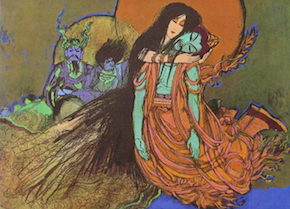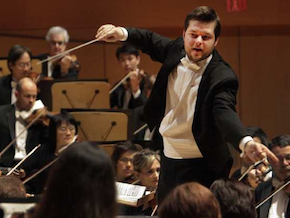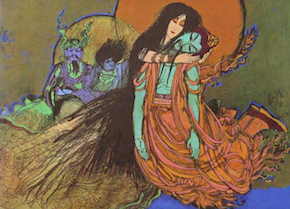
Uncredited artist for Capitol Records
At mid-season, musicians of the San Francisco Symphony look like post-season Giants: improbably amazin'! They (the orchestra) played Bartók's devilishly hard The Miraculous Mandarin magnificently, each section tasked to its physical-musical maximum, and then I looked down at the program and found this:
The Sunday matinee was the third performance of this program in 40 hours, meaning running the marathon three times in 2 1/2 days. Another note of importance, largely the result of the brilliant performance: a near-ovation audience response, the like of which I don't remember, certainly not in the U.S.
I say "largely" because the performance alone was not responsible for the big change from past walkouts from the audience and polite applause at best to this genuine appreciation of a great work: time, more open minds and ears better attuned to complexity also had a role. From Mahler to Stravinsky (and many others), "difficult" composers of the past are now accepted and relished by the general audience, not only connoisseurs. Bartók is right up there, especially with Mandarin, as challenging to the listeners (especially for the first time) as it is to the musicians.
The 1919 Mandarin came 14 years after Richard Strauss' kindred Salome, but it was still shocking and controversial, both presenting grotesque and overwhelming expressions of extreme passion and desire, with music that goes beyond boundaries.

The suite from the ballet opens with cacophonous music depicting a busy city, the brass — on heavy duty for almost all of the 30-minute work's length — and strings playing at a feverish pitch. Unshowy, rock-solid Slovakian conductor Jurah Valčuha held it all together, but not limiting individual expression (until the piano concerto, but more about that later), leading a performance of bold authenticity.
As the story emerges, of thugs using a prostitute to lure men to be robbed, it's the turn of woodwinds, led by Carey Bell's clarinet, to portray the victims. As the mysterious mandarin appears, Timothy Higgins' trombones and Michael Grebanier's cellos depict the girl's seductive dance, the man's response, the struggle between the two, the thugs' attacks on the mandarin — Bell again, and Elizabeth Koch Tiscione's oboe — and his refusal to die until fulfillment.
During the dramatic finale, Ragnar Bohlin's SFS Chorus sang the eerie, wordless music that's not always included in performances or recordings. I can see good reasons for inclusion or leaving the chorus out: It is both effective as an integral part of the music, and distracting as the audience is looking around, trying to spot the singers (they were backstage, beneath the organ, led by David Xiques).
It all became a moot point, based on the grand performance and the gratifying audience response. This Mandarin is entering into the Symphony record books, among memories to treasure.
With Juraj Valčuha and the orchestra still at their Bartókian apex, Garrick Ohlsson was wonderful ... The pianist's security, straightforward presentation, and musical insight are nonpareil.
Beyond doubt, the majority of the audience came for mostly for the second half of the concert, the Rachmaninov Piano Concerto No. 3, with Garrick Ohlsson — and they didn't have to perish to have their desire fulfilled, it was all anyone could have wished for. With Valčuha and the orchestra still at their Bartókian apex, Ohlsson was wonderful in the measured and just-right Allegro and the virtuoso brilliance of the Finale. The pianist's security, straightforward presentation, and musical insight are nonpareil.
In the inevitable standing ovation at the end, there might have been few wondering about the middle movement, but I was. The Adagio is the complex, romantic heart of the concerto, more than its wildly popular opening and closing. At the matinee, featuring Bell's clarinet again and Steve Dibner's bassoon, the music sounded expressive and bright, but more restrained than some (especially present company) would wish for. Was this perceived lack of more passion and lyricism the conductor's or soloist's responsibility? I cannot tell, but suspect it was Ohlsson's take on the work — and he richly deserves that right.
The concert opened with Steven Stucky's four-minute (that's right, 4) Jeu de timbres (orchestra bells), a blowsy, vibrant, loud piece that's fun, but is over by the time you try to get into it. Stucky wrote it in 2003 as an encore for a concert of French music, and it must have fit that purpose very well.

